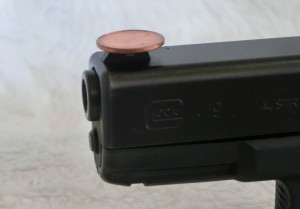This is the fifth in a series of simple exercises you can do to improve your trigger control. These exercises will help you become more aware of your trigger finger and better able to control its motions. No matter how fast you can draw or how dynamically you can move, you will not be prepared to defend yourself with a firearm until you can hit your target reliably. You cannot hit your target reliably until you develop good trigger control, and that’s what this series is about.
IMPORTANT SAFETY NOTE! Start with an empty firearm within the confines of your safe dry fire routine. Check to be sure it is really empty, then choose a safe direction. Never “dry fire” a gun outside of your safe dry fire routine. Before beginning this or any other dry fire drill, ALWAYS check the status of your gun to be sure it is unloaded. Regardless of the gun’s loaded or unloaded status, ALWAYS follow the universal rules of gun safety while you practice.
Exercise #5: Random Whistle Stop
Start with the skills you developed in Exercise #3: Save Your Pennies, and especially in Exercise #4: the Whistle Stop.
Can you keep a penny balanced on your front sight while you press the trigger slowly? Can you keep it there while you press the trigger quickly? Or on a signal? Excellent! Now you’re going to develop that trigger skill just a little further, by keeping the penny on your front sight when the timing of your trigger press is a complete surprise to you.
Here’s how: Just as you did in Exercise #4, you will need a smartphone timer app or some other way to give yourself a repeating “go” signal that you don’t directly control. But for this drill, you need an app that lets you set up a series of timers that will play in sequence.
Set those timers in an infinite loop in a mixed order, with some shorter times and some longer ones. The intervals should take anywhere from 2 seconds up to 6 or 7 seconds between beeps. Mix it up so you’ll never know how long you’ll be waiting for the next signal. This makes each beep a genuine surprise, which challenges your trigger control even more than a predictably-timed beep will do.
Now simply follow the same directions as in Trigger Awareness Exercise #4. Remember to press the trigger immediately when you hear the beep, and try to finish your trigger press before the beep stops. Press the trigger immediately and press it quickly, but don’t let the penny fall!
Lather, rinse, repeat.
(Watch this blog. More exercises to come!)





